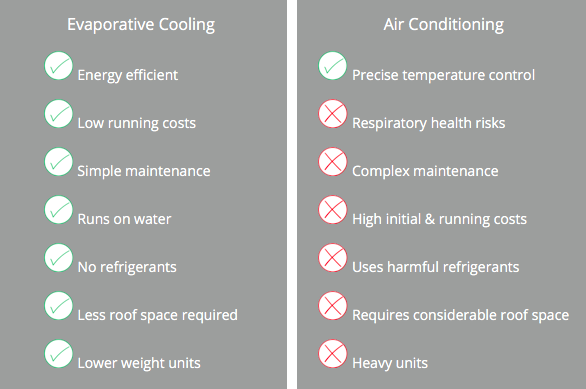03 October 2024
|

How can UK businesses effectively tackle the challenge of cooling commercial and industrial buildings? Mark Fishwick, Director of Manchester-based Inergy Group, explores one option.
In recent years, spiralling energy costs have put pressure on businesses looking for new and innovative ways to achieve the same result with less capital outlay and less maintenance.
New system installs have been put on hold and maintenance schedules squeezed, leaving many businesses with the challenge of managing ageing HVAC assets and deciding when and where to invest. Systems without regular maintenance can experience unpredictable downtime and parts availability is not always guaranteed.
While researching for my business, I came across evaporative cooling. An alternative cooling method that not only offers higher energy efficiency than traditional HVAC solutions but also has cheaper running costs. Since then, it‘s been our mission to develop and use this technology to tackle the cooling challenges in industrial processes.
Cooling challenges in industrial processes
With regard to cooling, many industrial processes have a high heat-gain, whereby the process itself generates heat which must be managed. There are numerous sectors where this is occurring, two prime examples from our customer experience are industrial scale bakeries and plastic moulding facilities.
In an industrial-scale bakery using modern production methods the production line may be operational 24 hours a day, 7 days a week. A constant production of heat and steam from large ovens working to high temperatures must be managed carefully especially given the health and safety requirements for food production areas.
Plastic moulding facilities manufacture a variety of end products from everyday items such as plastic bottles for household goods to more specialist storage and packaging products. In a plastic moulding facility heat is used to mould the liquid plastic, but chemical particles may also need extraction to maintain a safe working environment.
Production in any of these facilities can be adversely affected by the heat-gain in the process itself. Unplanned and unmanaged heat in any manufacturing facility can stop production resulting in a cascade of business interruption, lost revenues, damaged stock and missed productivity targets. All potentially severe impacts for any business to consider.
In addition to heat-gain from the industrial processes we should also note that UK air temperatures are rising; the top 10 warmest years for the UK since records began in 1884 have all occurred since 20021. As the UK continues to experience temperature rises and more seasonal fluctuations we need to look to those more experienced with warmer climates to optimise and improve our own approach to cooling these spaces.
Cooling a large industrial facility
Let’s consider options for cooling large commercial and industrial spaces. Most of us will be familiar with conventional air conditioning (AC) systems which remove both heat and moisture from the air using a chemical refrigerant. Cooled air is then re-circulated through the building and filtered as it returns to the unit.
Here are the key facts for conventional air conditioning:
- Temperature can be accurately controlled.
- Air is mostly recirculated within the space or building.
- The energy performance of the system is negatively impacted by high external temperatures i.e. The hotter the temperature outside the more energy is needed to maintain the desired temperature.
- Complete systems are expensive to install and maintain due to the more complex requirement associated to the refrigerants used within the units.
- The cost to run large systems is expensive resulting in high and unpredictable energy bills.
- Chemical refrigerants are used, ultimately negatively contributing to climate change.
Conventional AC isn’t a bad choice but, in our experience, it better suits smaller spaces. Given the challenges around high heat-gain in many industrial processes, conventional AC systems are often working at capacity to deliver the cooling levels needed in the space. This high demand therefore results in high-energy use which leads to rising energy bills.
A fantastic sustainable alternative to conventional AC is evaporative cooling. Historically championed in warmer climates, the technology delivers several benefits over and above conventional and familiar air conditioning.

Fresh, filtered air enters the system and is pulled though a water-soaked cooling pad where the heat is absorbed, lowering the air temperature. Cooled air is distributed through the space via a fan and a series of ducts
What is evaporative cooling?
Evaporative cooling (EC) systems, as the name suggests, use evaporation to cool the air. Surprisingly, no chemical refrigerants are needed for this process. Fresh, filtered air enters the system and is pulled though a water-soaked cooling pad where the heat is absorbed, lowering the air temperature. Cooled air is distributed through the space via a fan and a series of ducts.
Advancements in evaporative cooling technology represent a significant innovation in sustainable cooling. These systems provide efficient cooling while maintaining a comfortable humidity level.
Here are the key facts of evaporative cooling:
- Temperature and humidity can be accurately controlled.
- Indoor air quality (IAQ) is improved through the introduction of 100% fresh outside air this in turn improves employee comfort, health and wellbeing and supports good productivity.
- Cooling performance is further improved with increasing external temperatures – efficiency rises along with the temperatures.
- Initial capital outlay costs are relatively low, in comparison to a like-for-like conventional air conditioning system.
- Running costs are low, lowering energy bills and energy dependence.
Using only water to cool, combined with the lack of chemical refrigerant make evaporative cooling a responsible, energy efficient and sustainable choice for cooling your industrial or commercial workplace.
Lowering carbon footprint with evaporative cooling
When measuring a carbon footprint, you look at the amount of carbon dioxide directly or indirectly produced by your business. If an industry appliance uses a low level of electricity, it minimises the environmental impact 2.
Evaporative cooling systems contribute to lowering the carbon footprint of your premises in two main ways:
- Evaporative cooling systems use up to 82% less energy3 versus conventional air conditioning. This is a huge saving lasting for a lifespan of more than 15 years.
- Evaporative coolers consume up to 30% less water than conventional AC systems despite relying on water to provide the evaporation for the cooling effect.
Addressing industrial hotspots
Industrial manufacturing workplaces often have hot spots that are uncomfortable to work in and those spaces are not just hotter than the rest of the building, but hotter than external ambient conditions. Evaporative cooling can be used to “spot cool” these hot spots, reducing the need for multiple units to cool the entire space.
Evaporative cooling is a proven technology perfect for all kinds of HVAC applications across multiple industries, including manufacturing plants and commercial warehouses.

When cooling large areas, evaporative cooling is more cost-effective than traditional air conditioning. Not only is the initial capital outlay to design and install the system lower than conventional air conditioning, day-to-day running costs are lower due to the reduced energy demand from the sophisticated technology used in these coolers.
These cost savings are underpinned by the eco-friendliness of the technology. This can be further enhanced with supportive clean energy solutions like solar power.
References:
1. https://www.metoffice.gov.uk/research/climate/understanding-climate/uk-and-global-extreme-events-heatwaves
2. The Nature Conservancy – Calculate Your Carbon Footprint
3. The running costs comparison is a calculation based on assumptions including:
Building dimensions 1000m2 floor area x 6m high; Cooling time 12hrs/day, 6 summer months/year; Indoor temperature 22°C; Building heat load 100W/m²; Rooftop Unit – Fresh air 1,170 l/sec (20%); Rooftop Unit -COP 3; External ambient conditions based on Typical Meteorological Years (TMY) for Madrid (Spain); Power cost 0.11 €/kWh; Water cost 1.5 €/m³; Electricity Generation CO2 equivalent 340gCO2eq/kWh. The comparison should be used as a general guide only.








